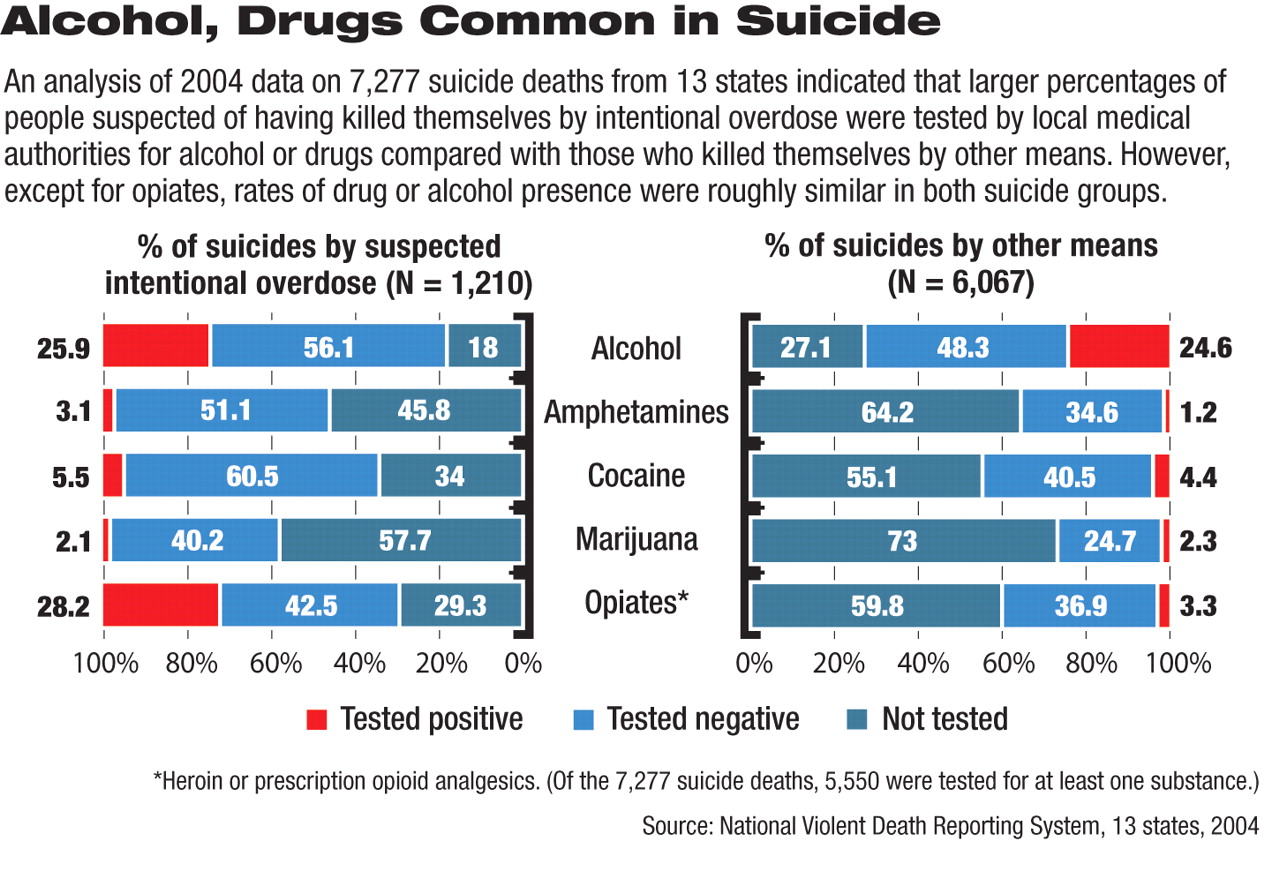A “substantial percentage” of suicide victims test positive for alcohol and other drugs but, except for opiates, the proportion of positive tests is similar in those who died by suspected intentional overdose and those who killed themselves by other means, according to a report in the November 24 Morbidity and Mortality Weekly Report (MMWR).
That, said researchers from the Centers for Disease Control and Prevention (CDC), “suggest[s] that use of alcohol or other drugs might contribute substantially to suicides overall, regardless of the cause of death.”
More complete reporting of toxicology test results might help in the development of better suicide-prevention interventions, said the researchers.“ Such data can be enhanced by uniform, comprehensive, toxicology testing practices on a state and national basis.”
While links between suicide and substance use are well known, the CDC drew on new data about 5,550 victims tested out of 7,277 suicides from 13 states reported in 2004 to the National Violent Death Reporting System (NVDRS).
Toxicology testing after suicide deaths varied widely among the states reporting, from 25.9 percent in Oregon to 97.7 percent in Virginia. Local policy and preferences of individual coroners or medical examiners seem to decide which suicide cases are tested for substance traces. Those officials may more frequently target cases in which alcohol or drugs are suspected to have caused or contributed to the deaths, but conduct toxicology tests less often when the cause of death seems clear and unrelated to substance use.
Overall, positive toxicology tests of people who committed suicide were recorded for alcohol (33.3 percent), opiates (16.4 percent), cocaine (9.4 percent), marijuana (7.7 percent), and amphetamines (3.9 percent). Opiates included both heroin and prescription drugs. The reports did not include data on amounts or chronicity of substance use.
“These percentages are much higher than you'd find in the general population,” said J. Raymond DePaulo, Jr., M.D., the Henry Phipps professor and chair of the Department of Psychiatry and Behavioral Sciences at Johns Hopkins University School of Medicine, in an interview with Psychiatric News.
“Poisoning” was defined as suspected intentional overdose. Similar percentages of poisoning-suicide and nonpoisoning-suicide victims tested positive for alcohol or other drugs, with the exception of opiates: 31.6 percent of poisoning suicides versus 33.6 percent of nonpoisoning cases were positive for alcohol, 5.8 percent versus 3.3 percent of cases were positive for amphetamines, and 8.3 percent versus 9.7 percent were positive for cocaine. The exception was opiates, for which 39.8 percent of those who killed themselves by poisoning tested positive, compared with only 8.2 percent of nonpoisoning victims.
“Associations with opiates may in part reflect the use of these drugs in people with chronic pain or serious illness, both of which are associated with increased suicide risk,” David Gunnell, M.B., Ph.D., professor of epidemiology in the Department of Social Medicine at the University of Bristol in England, told Psychiatric News. Gunnell is an expert on the epidemiology of suicide.
“Substances have a role in suicides, from several angles,” said DePaulo. “Depression leads to alcohol use, and alcoholism leads to depression. In people with depression, alcoholism not only worsens the depression but makes relapse into depression more likely even after recovery. A significant minority `pre-dose' themselves with alcohol, using its disinhibiting effects to make them less likely to back out of their decision to kill themselves.”
This use of alcohol and drugs to overcome barriers to suicide may explain why rates of substances found in suicide victims' bodies are similar, regardless of the means of death.
The NVDRS collects information on all violent deaths—homicides, suicides, unintentional deaths by firearms, legal interventions, or deaths of unknown intent from Alaska, Colorado, Georgia, Maryland, Massachusetts, New Jersey, North Carolina, Oklahoma, Oregon, Rhode Island, South Carolina, Virginia, and Wisconsin.
The system is not comprehensive, however. Even though substance abuse is a known risk factor for suicide, none of the 13 states performs routine drug or alcohol screenings on all suicide victims.
Inconsistent testing limits the value of the NVDRS data, said Gunnell.“ The data can only really be evaluated fully for those states where a high proportion of suicides were tested. In the states where only a small percentage were tested, the high yields likely reflect targeting of testing at those where drug or alcohol misuse were already considered potentially contributory.”
The NVDRS also did not report on toxicology results for psychotropic drugs. A separate study of 333 consecutive suicides in Mobile, Ala., from 1990 through 1998 found that 20 percent of the victims had traces of antidepressants in their systems, which might be considered low today.
A study of forensic data from a subset of young suicide victims in Utah who killed themselves between 1996 and 2002 found that alcohol and methamphetamine were the most common substances found in their blood or urine. The low levels of antidepressants found may have indicated either undiagnosed mental illness or failure to take prescribed medications, the Utah researchers suggested.
“It's important that future studies screen for psychotropics and antidepressants” in the bodies of suicide victims, said DePaulo. That would better indicate treatment or compliance patterns.
More comprehensive toxicology testing linked with demographic data could offer clues into how suicide trends change over time and geography, said the MMWR report. Such information could help target populations at risk for suicide and focus preventive measures on those groups.
“Toxicology Testing and Results for Suicide Victims—13 States 2004” is posted at<www.cdc.gov/mmwr/preview/mmwrhtml/mm5546a1.htm>.▪

